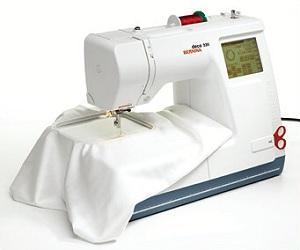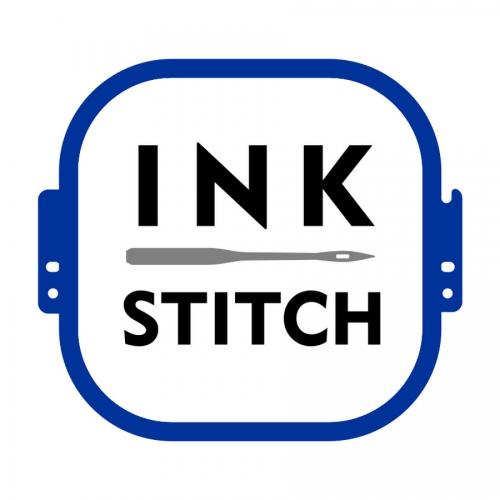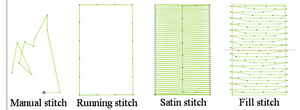Search the Community
Showing results for tags 'manual'.
-
Does anyone have the manual to Baby Lock Ellure ESL? It is not available to download. This is a new to me machine. I have never used embroidery machine. I am trying to figure out all the things I need to know. I can not find out how to put the needle on the right side of the zipper foot. Any help will be appreciated. I found the manual and have attached file. Lottieoops Ellure ESL.pdf
-

Machine embroidery stitch types and limitations
diver361 posted a blog entry in Embroideres com: tips.
When your learning to digitize it is very important that you understand what the different stitch types and when they should be used. Depending on your level it will depend on what tools you have. Embroidery stitch types There are three main categories of stitches in your software these stitch types can take form in many different ways. The three stitch types includes the run style stitch, satin style stitch and the fill style stitch. Lets take a closer look at them and when to use them. Run Stitches A run stitch should be used when you need a thin line, either as a traveling stitch, underlay or decorative stitch. These do not have any push or pull on the fabric, but they can sink into some fabrics and you may need to use a bean or two ply stitch to get a desired result. Stitch length should be between .03 to .15. Satin Stitch The satin stitch is the main style of stitches for most fonts, it works best in situations where the stitch is not uniform, and works best between .03 to .35 inches thick,depending on your machine you may be able to get up to .42 inch or .51 inch but it will often be loopy. Fill Stitch The fill stitch come in many shapes and patterns but it can be used to fill any area where a satin doesn't work, great on areas .10 to infinite. However on large fills you may want to look at applique. You can use it in smaller applications but tends to distort at smaller sizes. Fills are great for blends. There are some other stitch type you will see in your software and they are all based from the three basic stitch types. Manual Tool This tool is very similar to the run tool except for a value for the stitch length you can place your stitches randomly as needed, however watch your stitch length. Steil Stitch This is very similar to a satin except its a zigzag and only one line, so the thickness is uniform. recommend for borders where its even and works best between .03 to .20 This tool is based on the run tool it repetitive pattern. Programmed Fills These unique patterns are based on the run tool, they have 1 start point 1 except point and they have to start and end in a repetitive pattern. Column Tool Is based on a Satin stitch where you draw the outline and it adds the stitches depending on the density. Enhanced Column Tool This is like the Column tool its based on the satin style of stitches but allows you to corner or bend the lines, where the column tools is for straight lines. Fill ToolThis tool was based on the run style of stitches however its now its own stitch type , there are hundreds of patterns made by changing the stitch type and creative effects, including the carved style of stitches, similar tools may include cascade fill, cross stitch fill. The rules for these tools are not set in stone, you can manipulate them to suit your needs in the advance blogs we will be covering blending, shadows, wave fills etc. These are all based on the basic tools. Machine embroidery design characteristic When a customer shows you a designs you first should be able to recognize what stitches you will need to use, you should also be able to see what is in the for ground and background. This is generically called pathing. Pathing is basically mapping the design, it allows you to hide some stitches and be able to reduce the amount of trims as the stitches are not trimming or jumping. A good digitizer is able to path a design prior to digitizing it. Any embroidery will tell that they can recognize a poorly digitized design as it causes their machine to clunk and has unnecessary trims, or too many trims which can cause simulated thread breaks, or worse. -
-
Need help finding FREE User Manuals for my Tajima TEHX-C1501. Just bought the machine and need to learn how to use it. Where can I find one? Thanks, tsruiz
- 1 reply
-
- 1
-

-
- manual
- embroidery
-
(and 3 more)
Tagged with:
-
The four pillars of stitch types
Irina posted an article in Machine embroidery materials and technology
Original text by Marina Belova All machine embroidery designs are made with only 4 basic types of stitches. All other stitches that can be created in various embroidery editors are just the offsprings of these basic types. Even the most complex design is a combination of these 4 basic types. The main types of stitches are: Manual stitch Running stitch (also called Walking stitch) Satin stitch (also Column stitch) Tatami (Fill, Seeding stitch, and so on) I'll describe each of these types in a few words. First: Manual stitch This is the most basic stitch type in embroidery. Every separate stitch is created manually, without using the automatics. Manual stitch can be used instead of the auto-generated running stitch when it's not possible to create the desired effect with the help of the editor. Second: Running stitch Running stitch is considered the simplest and most creative stitch at the same time. Why is that? Because a digitizer, not the software, controls every stitch that is laid on the fabric. Running stitch has a small number of properties: 1. Stitch length (one should avoid short stitches) 2. Number of runs (how many times every stitch is repeated) For example: Single running stitch Double running stitch Triple running stitch Motif stitch (follows an established pattern) There are several effects that can be applied to the running stitch. Their variety depends on your embroidery software. For example: Variable stitch length for better registration Stitch offset (or Swing) Shifting rows of needle penetrations with several repeats There is a large number of occasions on which the running stitch can be used: Design details Decoration (motifs) Contours (the most complex outlines) Manual understitching The Outline Designs Redwork Quilt Jump stitches between the objects Preliminary stitches (basting stitches, guidelines) But the greatest advantage of this type is that it makes the least impact on the fabric of all four. Compare 2 basic stitch types here. Third: Satin stitch Satin is the type of stitch that is most widely used. It consists of stitches that can change their angle after every penetration. There can be more than one stitch angle in the object embroidered with satins. When creating satin stitch objects you should pay attention to: Stitch length (it's necessary to avoid too long or too short stitches) Stitch angle Stitch density Pull compensation Push compensation Stitch shortening Edge shape There are tons of effects that can be applied to satins. Their variety depends on your embroidery software. For example: Satin stitch with consistent width (Satin border, Satin column, Serial satin) Tatami Patterns Decorative fills Feathering (jagged edge) Variable density Radial fill Satin stitches are used for creating the following objects: Small lettering Contours Column of varying geometry FSL (lace that does not use the fabric as a basis) Satin is also used for creating dancing shadows as its surface reflects the sunshine Satin distorts fabrics. Fourth: Fill Fill consists of rows of running stitches that form patterns in accordance with needle penetration parameters. An object made with these stitches usually has only one stitch angle. There is a handful of parameters that should be controlled when using this type of stitches to create objects: Stitch length (it's necessary to avoid too long or too short stitches) Stitch angle Density Pull compensation Push compensation Edge shape (sharp, square/straight, chiseled/acute) What other effects than can be applied to the fills? Their variety depends on your embroidery software. For example: Decorative fills Motif fills (can be programmed) Waving effect – bending the fill along one or two curves Spiral fill Gradient fill Textures Feathering Fills are used for large embroidery areas. They distort fabrics the most. P.S.: Some other stitch typologies Having written this article I encountered Helen Hart Momsen's, a famous digitizer's, article called The Building Blocks Of Embroidery in the Printwear magazine. Helen thinks that there are only two stitch types: running stitches and satin stitches. Manual stitch, according to her, is a running stitch where the position and length of every individual stitch are determined by a digitizer and not the software. She also doesn't think that filling stitches should be singled out as fills are simply clusters of running stitches. Traditionally, there are only three stitch types: Running stitch Satin stitch Fill- 3 comments
-
- stitch types
- manual
-
(and 1 more)
Tagged with:
-
Adjusting Thread Trim Length
Berez posted a topic in Questions and Answers about embroidery machines
Hi, It's been a long time since I had to make any trim adjustments on my embroidery machine and I can't remember where to go. I have looked in the manual, but can't find the right spot. I have a Tajima TEHX 1501C single head embroidery machine. Can someone tell where to go on the machine to reduce the thread trim length? I would much appreciate the help.-
- Tajima TEHX 1501C
- trim length
-
(and 4 more)
Tagged with:
-
Sierra embroidery office manual - version 11.40.. PDF format EOD_S_9.pdf
- 2 replies
-
- Embroidery Offices
- Sierra
-
(and 4 more)
Tagged with:






